Bandwidth Enhancement of a V-Band Klystron with Stagger-Tuned Multiple Radial Re-Entrant Cavities
Abstract
:1. Introduction
2. Design Approach
3. Results and Analysis
4. Conclusions
Author Contributions
Funding
Institutional Review Board Statement
Informed Consent Statement
Data Availability Statement
Conflicts of Interest
References
- Qiu, J.; Levush, B.; Pasour, J.; Katz, A.; Armstrong, C.; Whaley, D.; Tucek, J.; Kreischer, K.; Gallagher, D. Vacuum tube amplifiers. IEEE Microw. Mag. 2009, 10, 38–51. [Google Scholar] [CrossRef]
- Gilmour, A.S. Klystrons, Traveling Wave Tubes, Magnetrons, Crossed-Field Amplifiers, and Gyrotrons; Artech House: Norwood, MA, USA, 2011. [Google Scholar]
- Kornfeld, G.K.; Bosch, E.; Gerum, W.; Fleury, G. 60-GHz space TWT to address future market. IEEE Trans. Electron Devices 2001, 48, 68–71. [Google Scholar] [CrossRef]
- Alavi, S.E.; Soltanian, M.R.K.; Amiri, I.S.; Khalily, M.; Supa’at, A.S.M.; Ahmad, H. Towards 5G: A photonic based millimeter wave signal generation for applying in 5G access fronthaul. Sci. Rep. 2016, 6, 19891. [Google Scholar] [CrossRef] [PubMed]
- Gao, D.; Zhang, Z.; Ding, Y.; Shen, B.; Ding, H.; Zhang, Z.; Cao, J.; Gu, H.; Wang, C.; Wang, F. Development of an S-Band High Average Power Multibeam Klystron With Bandwidth of 10%. IEEE Trans. Electron Devices 2014, 61, 159–165. [Google Scholar] [CrossRef]
- Ding, Y.; Shen, B.; Shi, S.; Cao, J. S-Band Multibeam Klystron With Bandwidth of 10%. IEEE Trans. Electron Devices 2005, 52, 889–894. [Google Scholar] [CrossRef]
- Bansiwal, A.; Raina, S.; Datta, S.; Vinoy, K. A Broadband Rectangular Reentrant Cavity for Multiple-Beam Klystron. IEEE Trans. Electron Devices 2019, 66, 3168–3170. [Google Scholar] [CrossRef]
- Qu, Z.; Zhang, Z.; Fan, J.; Zhang, R.; Liu, P. Development of a C-Band 2.5-MW Peak Power Broadband Klystron Based on High Efficiency. IEEE Trans. Plasma Sci. 2014, 42, 79–83. [Google Scholar] [CrossRef]
- Balkcum, A.; Mizuhara, A.; Stockwell, B.; Begum, R.; Cox, L.; Forrest, S.; Perrin, M.; Zitelli, L.; Hoppe, D.; Britcliffe, M.; et al. Design and Operation of a 100 kW CW X-Band klystron for spacecraft communications. In Proceedings of the IVEC-IVESC, Montery, CA, USA, 24 April 2012; pp. 315–316. [Google Scholar]
- Zhang, Z.; Shen, B.; Yu, X.; Zhu, F.; Han, Y.; Huang, Y.; Zhang, F. Development of an S-band 22-kW-average power-klystron with 7.14% relative bandwidth. IEEE Trans. Electron Devices 2011, 58, 2789–2795. [Google Scholar] [CrossRef]
- Levin, M.E. 2 kw, 250 MHz bandwidth, Ku-BAND klystron amplifier. In Proceedings of the 1976 International Electron Devices Meeting, Washington, DC, USA, 6–8 December 1976; pp. 393–396. [Google Scholar]
- Kbeuchen, K.H.; Auld, B.A.; Dixon, N.E. A Study of Broadband Frequency Response of the Multicavity Klystron Amplifier. J. Electron. Control 1957, 2, 529–567. [Google Scholar] [CrossRef]
- Simth, M.J.; Phillips, G. Power Klystrons Today; Research Studies Press Ltd.: Baldock, UK, 1995. [Google Scholar]
- Barker, R.J.; Booske, J.H.; Luhmann, N.C.; Nusinovich, G.S. Klystron in Modern Microwave and Millimeter-Wave Power Electronics, 1st ed.; IEEE Press: Piscataway, NJ, USA, 2005; pp. 131–147. [Google Scholar]
- Symons, R.S.; Vaughan, R.M. The linear theory of the clusteredcavity klystron. IEEE Trans. Plasma Sci. 1994, 22, 713–718. [Google Scholar] [CrossRef]
- Erling, L.L.; Albert, M. Wideband tunable klystron amplifier for satellite earth stations. In Proceedings of the 1974 International Electron Devices Meeting (IEDM), Washington, DC, USA, 5–8 December 1974; pp. 363–366. [Google Scholar]
- Pasour, J.; Wright, E.; Nguyen, K.T.; Balkcum, A.; Wood, F.N.; Myers, R.E.; Levush, B. Demonstration of a Multikilowatt, Solenoidally Focused Sheet Beam Amplifier at 94 GHz. IEEE Trans. Electron Devices 2014, 61, 1630–1636. [Google Scholar] [CrossRef]
- Ju, J.; Zhang, J.; Shu, T.; Zhong, H. An Improved X-Band Triaxial Klystron Amplifier for Gigawatt Long-Pulse High-Power Microwave Generation. IEEE Electron Device Lett. 2017, 38, 270–272. [Google Scholar] [CrossRef]
- Wessel-Berg, T. Basics of radial sheet beam interactions with potential applications in the microwave K and W bands. In Proceedings of the AIP Conference, Kalamata, Greece, 3 January 2006; Volume 807. [Google Scholar]
- Dal Forno, M.; Tantawi, S.G.; Ruth, R.D.; Jensen, A. Progress on design of radial klystrons. In Proceedings of the IEEE International Vacuum Electronics Conference (IVEC), Montery, CA, USA, 19–21 April 2016. [Google Scholar]
- Naidu, V.B.; Gope, D.; Datta, S.K. Enhancement of Bandwidth of an Extended Interaction Klystron by Symmetric Loading. IEEE Trans. Plasma Sci. 2022, 50, 5018–5022. [Google Scholar] [CrossRef]
- Paoloni, C. Periodically Allocated Reentrant Cavity Klystron. IEEE Trans. Electron Devices 2014, 61, 1687–1691. [Google Scholar] [CrossRef]
- Yong, W.; Ding, Y.-G.; Liu, P.-K.; Zhang, J.; Wang, S.-G.; Lu, X. Development of an S-band klystron with bandwidth of more than 11%. IEEE Trans. Plasma Sci. 2006, 34, 572–575. [Google Scholar] [CrossRef]
- Nguyen, K.T.; Wright, E.L.; Pershing, D.E.; Abe, D.K.; Petillo, J.J.; Levush, B. Broadband High-Power 18-Beam S-Band Klystron Amplifier Design. IEEE Trans. Electron Devices 2009, 56, 883–890. [Google Scholar] [CrossRef]
- Boyd, M.R.; Dehn, R.A.; Hickey, J.S.; Mihran, T.G. The multiple-beam klystron. IRE Trans. Electron Devices 1962, 9, 247–252. [Google Scholar] [CrossRef]
- Bansiwal, A.; Raina, S.; Vinoy, K.J.; Datta, S.K. A Post-Loaded Rectangular Reentrant Cavity for Broadband Multiple-Beam Klystron. IEEE Electron Device Lett. 2020, 41, 916–919. [Google Scholar] [CrossRef]
- Paoloni, C.; Mineo, M.; Yin, H.; Zhang, L.; He, W.; Robertson, C.W.; Ronald, K.; Phelps, A.D.R.; Cross, A.W. Microwave coupler for W-band micro reentrant square. IET Microw. Antennas Propag. 2016, 10, 764–769. [Google Scholar] [CrossRef]
- Kumar, M.S.; Maity, S.; Shee, S.; Bandyopadhyay, A.K.; Pal, D.; Koley, C. Design Studies of Re-Entrant Square Cavities for V-Band Klystrons. Electronics 2022, 12, 6. [Google Scholar] [CrossRef]
- CST 2023, User’s Manual, CSST. Available online: www.cst.com (accessed on 4 August 2023).
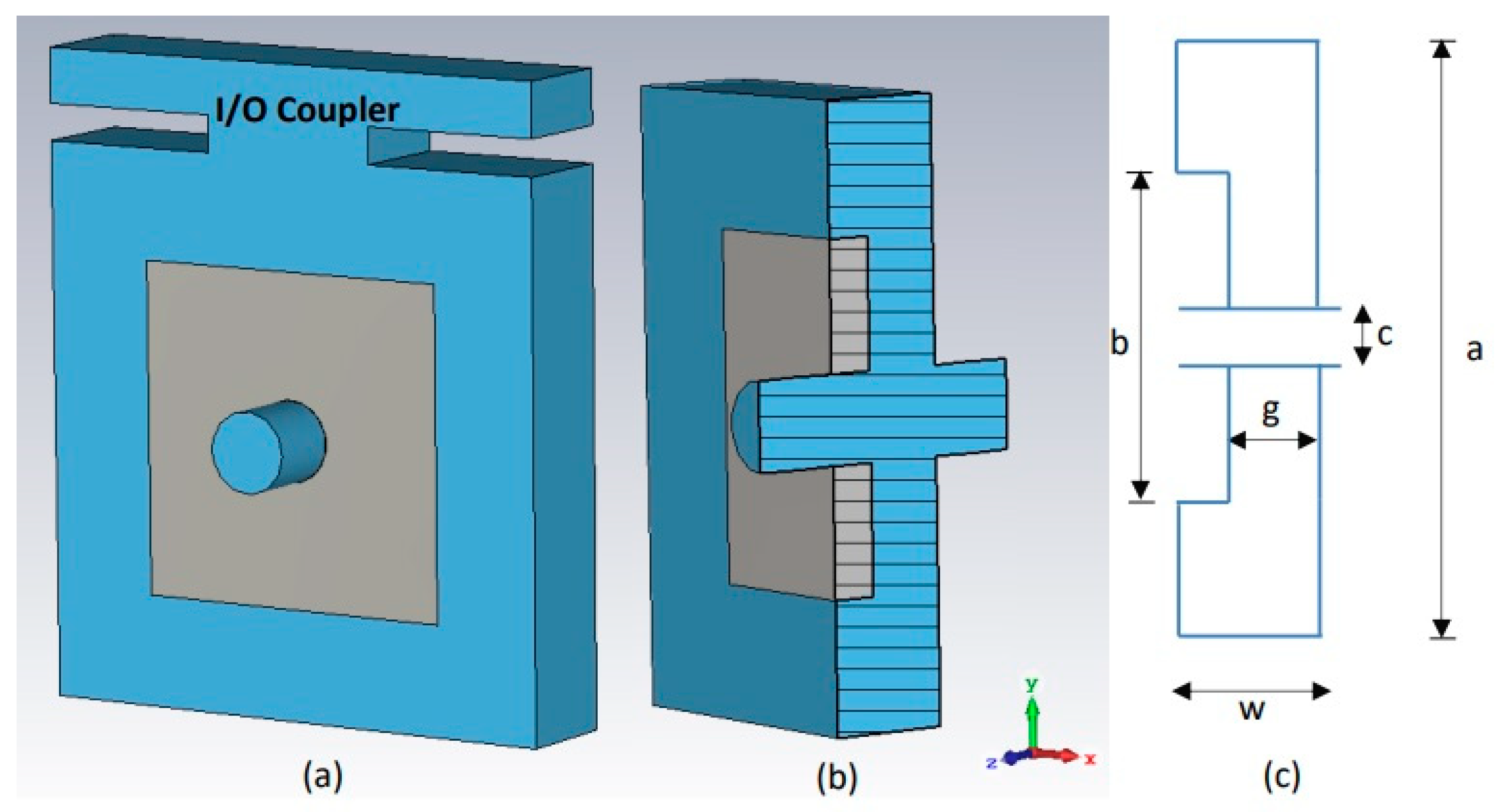
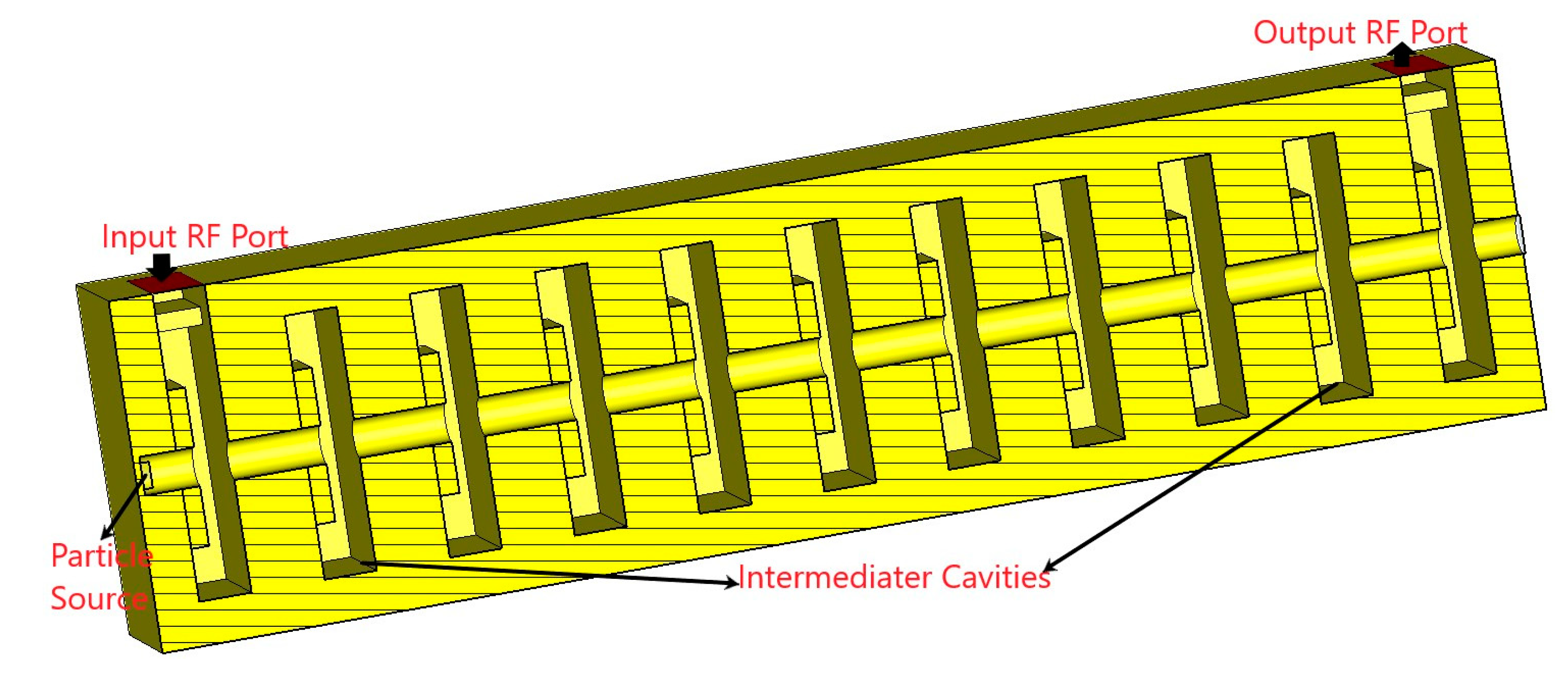



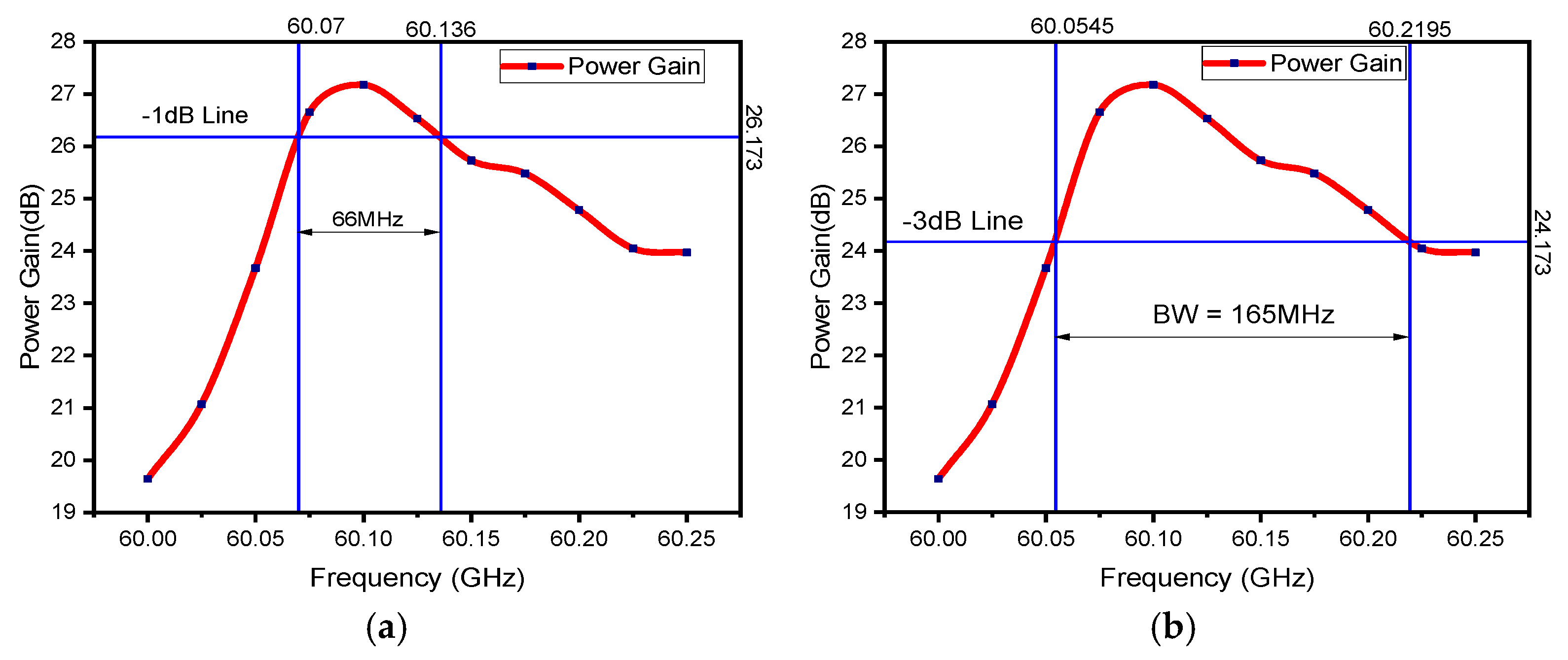

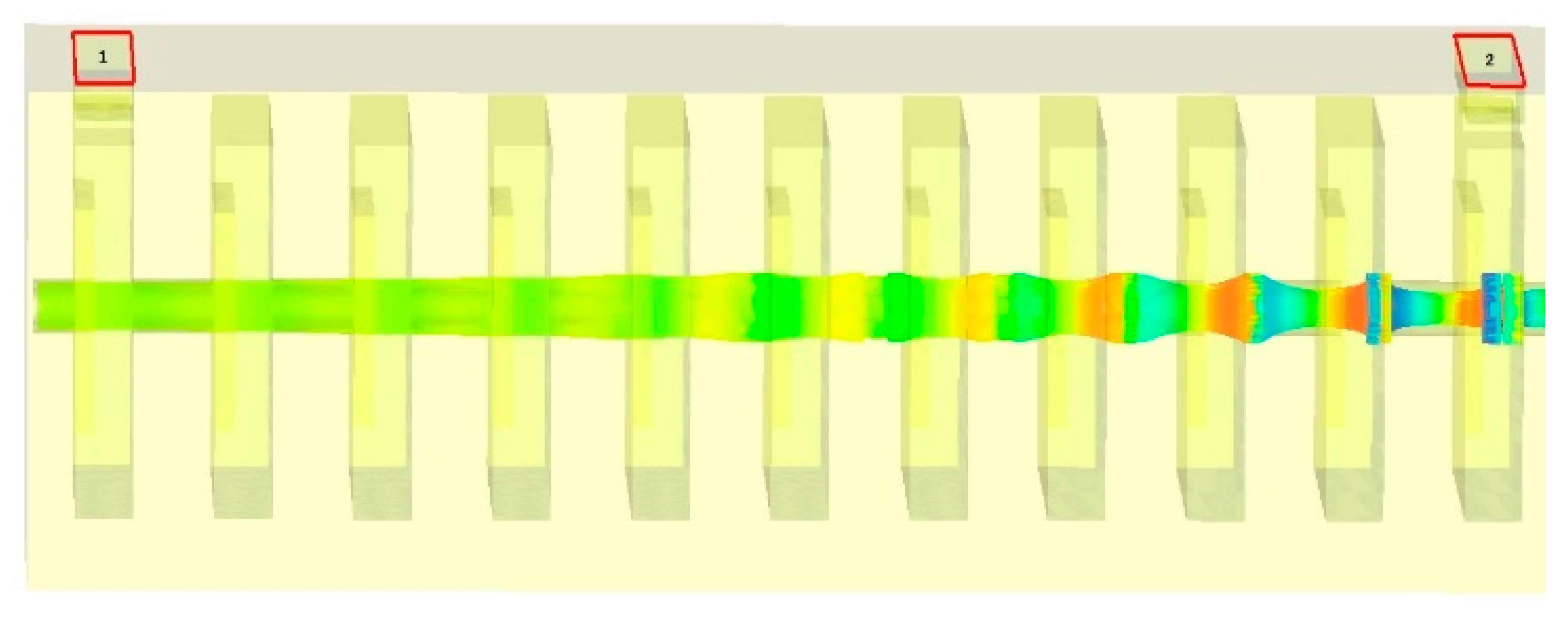


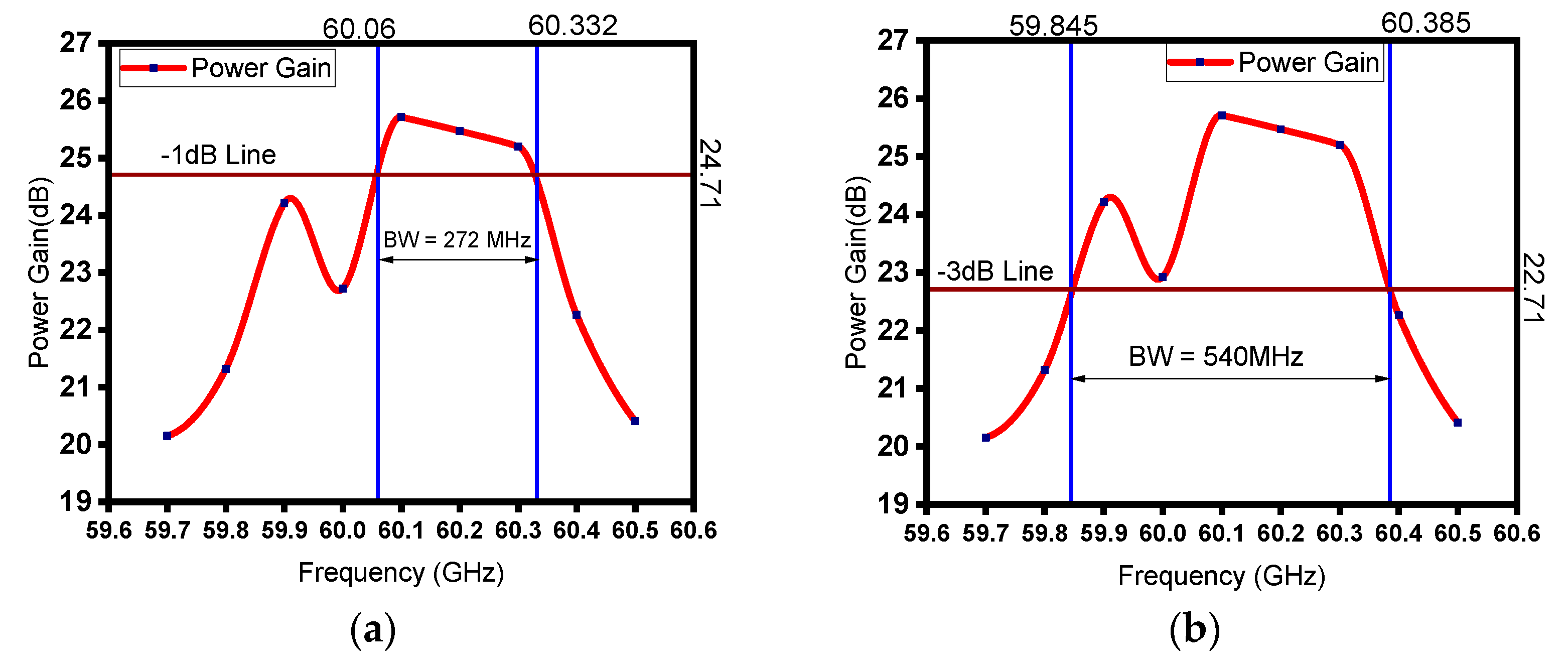
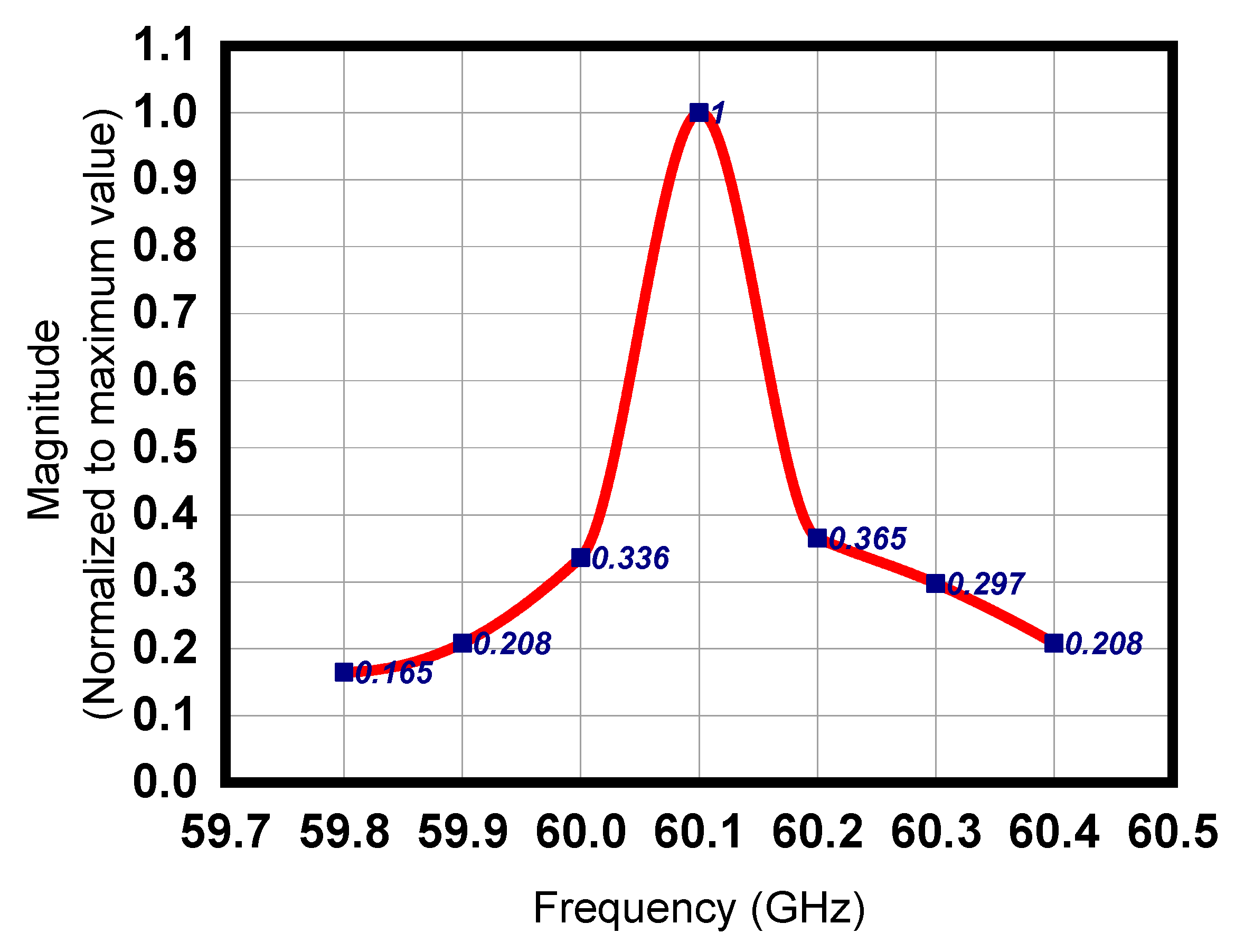
| Cavity Type | Dimensions (mm) | Simulation Results | ||||||
|---|---|---|---|---|---|---|---|---|
| a | w | b | g | c | Q | R/Q (Ω) | f (GHz) | |
| Input–output RRSC | 3 | 0.6 | 1.8 | 0.395 | 0.22 | 1364 | 86 | 60.1 |
| Intermediate RRSC | 3 | 0.6 | 1.7 | 0.38 | 0.22 | 1359 | 85 | 60.1 |
| Intermediate Cavity Type | Dimensions (mm) | Simulation Results | ||||||
|---|---|---|---|---|---|---|---|---|
| a | w | b | g | c | Unloaded Q (Q0) | R/Q (Ω) | f (GHz) | |
| IC1 | 3 | 0.6 | 1.75 | 0.3875 | 0.22 | 1346 | 85.7 | 60.42 |
| IC9 | 3 | 0.6 | 1.6 | 0.38 | 0.22 | 1384 | 89.2 | 60.12 |
| IC8 | 3 | 0.6 | 1.6 | 0.38 | 0.22 | 1384 | 89.2 | 60.12 |
| IC7 | 3 | 0.6 | 1.6 | 0.38 | 0.22 | 1384 | 89.2 | 60.12 |
| IC6 | 3 | 0.6 | 1.6 | 0.38 | 0.22 | 1384 | 89.2 | 60.12 |
| IC5 | 3 | 0.6 | 1.6 | 0.38 | 0.22 | 1384 | 89.2 | 60.12 |
| IC4 | 3 | 0.6 | 1.6 | 0.38 | 0.22 | 1384 | 89.2 | 60.12 |
| IC3 | 3 | 0.6 | 1.6 | 0.38 | 0.22 | 1384 | 89.2 | 60.12 |
| IC2 | 3 | 0.6 | 1.6 | 0.38 | 0.22 | 1384 | 89.2 | 60.12 |
| Input–Output RRSC | 3 | 0.6 | 1.8 | 0.395 | 0.22 | 1364 | 86 | 60.1 |
| Parameter | Synchronous Tuning | Stagger Tuning | Units |
|---|---|---|---|
| Beam Voltage | 20 | 20 | KV |
| Beam Current | 200 | 200 | mA |
| Operating Frequency | 60.1 | 60.1 | GHz |
| Input RF Power | 0.5 | 0.5 | W |
| Output RF Power | 256 | 186 | W |
| Power Gain | 27.13 | 25.61 | dBs |
| −1dB Bandwidth | 66 | 272 | MHz |
| −3 dB Bandwidth | 165 | 540 | MHz |
| Focusing Magnetic Field | 0.2 | 0.2 | T |
| Length of RF Circuit | 16 | 16 | mm |
Disclaimer/Publisher’s Note: The statements, opinions and data contained in all publications are solely those of the individual author(s) and contributor(s) and not of MDPI and/or the editor(s). MDPI and/or the editor(s) disclaim responsibility for any injury to people or property resulting from any ideas, methods, instructions or products referred to in the content. |
© 2023 by the authors. Licensee MDPI, Basel, Switzerland. This article is an open access article distributed under the terms and conditions of the Creative Commons Attribution (CC BY) license (https://creativecommons.org/licenses/by/4.0/).
Share and Cite
Kumar, M.S.; Maity, S.; Mandal, S.; Pal, D.; Koley, C.; Bandyopadhyay, A.K. Bandwidth Enhancement of a V-Band Klystron with Stagger-Tuned Multiple Radial Re-Entrant Cavities. Sensors 2023, 23, 7471. https://doi.org/10.3390/s23177471
Kumar MS, Maity S, Mandal S, Pal D, Koley C, Bandyopadhyay AK. Bandwidth Enhancement of a V-Band Klystron with Stagger-Tuned Multiple Radial Re-Entrant Cavities. Sensors. 2023; 23(17):7471. https://doi.org/10.3390/s23177471
Chicago/Turabian StyleKumar, M. Santosh, Santigopal Maity, Soumaya Mandal, Debasish Pal, Chaitali Koley, and Ayan Kumar Bandyopadhyay. 2023. "Bandwidth Enhancement of a V-Band Klystron with Stagger-Tuned Multiple Radial Re-Entrant Cavities" Sensors 23, no. 17: 7471. https://doi.org/10.3390/s23177471
APA StyleKumar, M. S., Maity, S., Mandal, S., Pal, D., Koley, C., & Bandyopadhyay, A. K. (2023). Bandwidth Enhancement of a V-Band Klystron with Stagger-Tuned Multiple Radial Re-Entrant Cavities. Sensors, 23(17), 7471. https://doi.org/10.3390/s23177471







